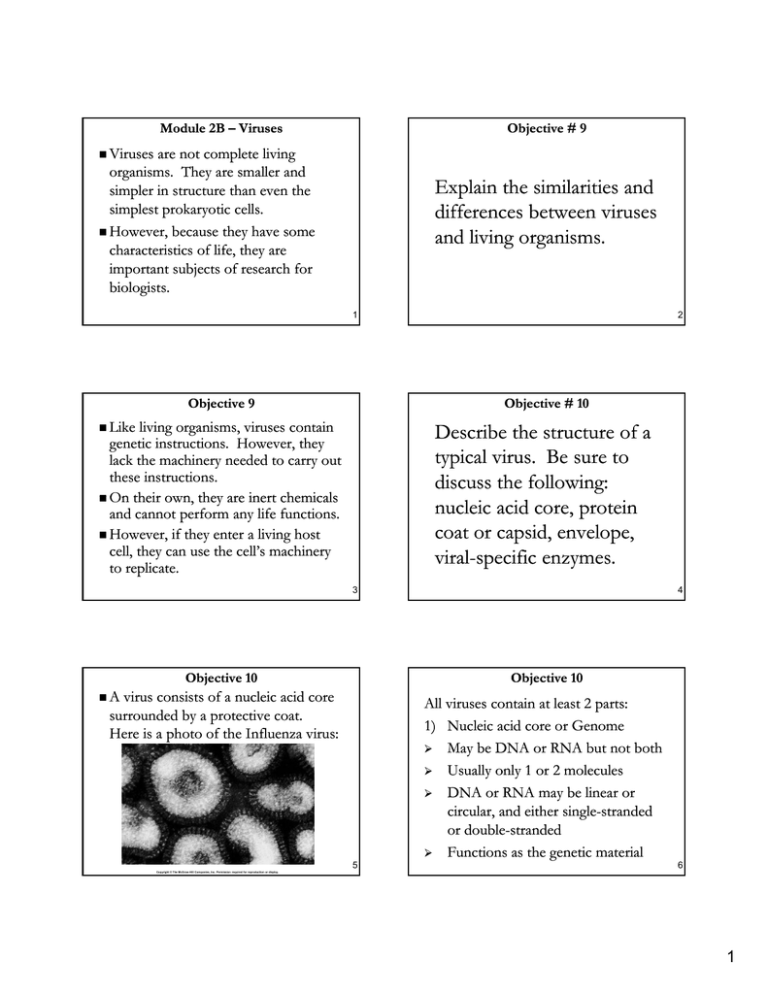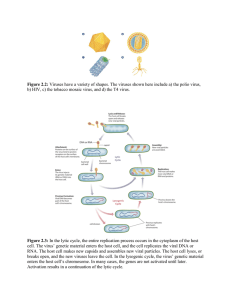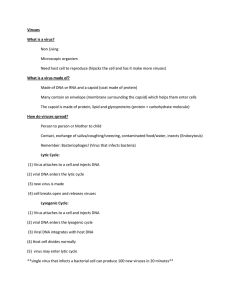Explain the similarities and differences between viruses and living
advertisement

Module 2B – Viruses Objective # 9 Viruses are not complete living organisms. They are smaller and simpler in structure than even the simplest prokaryotic cells. However, because they have some characteristics of life, they are important subjects of research for biologists. Explain the similarities and differences between viruses and living organisms. 1 2 Objective 9 Objective # 10 living organisms, viruses contain genetic instructions. However, they lack the machinery needed to carry out these instructions. On their own own, they are inert chemicals and cannot perform any life functions. However, if they enter a living host cell, they can use the cell’s machinery to replicate. Describe the structure of a typical virus. Be sure to discuss the following: nucleic acid core, protein coat or capsid, envelope, viral--specific enzymes. viral Like 3 4 Objective 10 Objective 10 virus consists of a nucleic acid core surrounded by a protective coat. Here is a photo of the Influenza virus: All viruses contain at least 2 parts: 1) Nucleic acid core or Genome ¾ May be DNA or RNA but not both ¾ Usually only 1 or 2 molecules ¾ DNA or RNA may be linear or circular, and either singlesingle-stranded or doubledouble-stranded ¾ Functions as the genetic material A 5 6 Copyright © The McGraw-Hill Companies, Inc. Permission required for reproduction or display. 1 Objective 10 Objective 10 2) Protein coat or Capsid ¾ Surrounds and protects the nucleic acid core ¾ Composed of one or a few proteins repeated many times ¾ Shape is usually helical or icosahedral icosahedral.. An icosahedron may look spherical on lower power, but is actually composed of 20 equilateral triangular facets: Viruses with helical and icosahedral capsids: RNA Capsid DNA Structure Capsid Virus Viral shape 7 Plant virus (TMV) Head viruses have a complex capsid with binal (two(two-fold) symmetry that is neither purely icosahedral nor helical ¾ For example, p the capsid p of TT-even bacteriophages consists of a head that is an elongated icosahedron attached to a tail that is helical. Tail fibers and a base plate are also present: DNA ¾ Some Capsid (protein sheath) Collar Tail Whiskers Base plate Objective 10 Icosahedral capsid Copyright © The McGraw-Hill Companies, Inc. Permission required for reproduction or display. Objective 10 9 Animal virus (Adenovirus) Helical capsid 8 Complex capsid of a T-even phage consists of an icosahedral head attached to a helical tail with tail fibers and base plate Tail fiber Copyright © The McGraw-Hill Companies, Inc. Permission required for reproduction or display. 10 Objective 10 In addition to a genome and capsid, some viruses also have: 3) Envelope ¾ Su Surrounds ou ds tthee capsid caps d ¾ Rich in lipids, proteins, and glycolipids ¾ Derived from the host’s cell membrane, but also contains proteins coded by viral genes 4) ViralViral-specific enzymes ¾ Enzymes the virus needs, but that are not supplied by the host cell ¾ Coded by the viral genome ¾ Stored inside the capsid 11 12 2 Viral Diversity Envelope protein Envelope VIRUS HIV BACTERIUM Streptococcus 110 nm VIRUS Rabies 1 µm VIRUS Herpes simplex VIRUS VIRUS Flavivirus VIRUS VIRUS Adenovirus Poliovirus (causes 30 nm yellow Influenza 75 nm 100 nm fever) 22 nm 125 nm 150 nm p Capsid VIRUS Poxvirus VIRUS T2 bacteriophage 250 nm PROTEIN Hemoglobin 15 nm 65 nm Viral-specific Enzyme EUKARYOTE Yeast cell BACTERIUM E. coli 2 mm long 7 mm long RNA Enveloped virus Copyright © The McGraw-Hill Companies, Inc. Permission required for reproduction or display. Copyright © The McGraw-Hill Companies, Inc. Permission required for reproduction or display. 13 Objective # 11 14 Objective 11 Head Bacteriophages, Explain what a bacteriophage is, and be able to name and describe the 2 types of reproductive cycles found in bacteriophages. called phages for short, are viruses that infect bacteria. DNA Capsid (protein sheath) Collar Tail Whiskers Base plate 15 Tail fiber Copyright © The McGraw-Hill Companies, Inc. Permission required for reproduction or display. 16 Objective 11 Two types of reproductive cycles are found in bacteriophages: 1) Lytic cycle: ¾ Phage g exists free in the host cell’s cytoplasm. ¾ Phage replicates and the new phages are released by lysis (bursting) of the host cell. 17 18 3 Objective 11 2) Lysogenic cycle: ¾ Phage DNA is integrated into the host cell’s DNA. ¾ P Phage age DNA DN can ca remain e a inactive act ve and a d be replicated along with the host DNA for many generations. ¾ Under certain conditions, phage will enter lytic cycle and lyse the host cell. Copyright © The McGraw-Hill Companies, Inc. Permission required for reproduction or display. Lytic Cycle Attachment: virus attaching to cell wall Bacterial chromosome Penetration: viral DNA injected into cell Bacteriophage Life Cycles Release: lysis of cell Lysogenic Cycle Synthesis: protein and nucleic acid Integration of genome l d to prophage leads h Propagation of prophage along with host genome Cell stress Reproduction of lysogenic bacteria 19 Assembly: involves spontaneous assembly of capsid and enzyme to insert DNA Objective # 12 Induction: prophage exits the bacterial chromosome, viral genes are expressed Objective 12 One group of animal viruses are the retroviruses.. retroviruses Retroviruses are enveloped viruses that have an RNA ggenome. Once inside a host cell, they use the enzyme reverse transcriptase to make a DNA copy of their RNA genome. HIV is an example of a retrovirus. Describe the life cycle of a representative animal virus, such as HIV HIV. 21 22 23 24 4 25 26 27 5




